How you handle the lead-up to a big race can make a difference in how much you enjoy it
Every racer and autocrosser has milestone moments. Maybe it’s the first time you race against someone really fast. Maybe it’s your first U.S. Majors Tour race or national-level autocross event or professional race. Whichever, there’s going to be uncertainty and nervousness. How a racer prepares for it can make all the difference in how things play out.
“You’ll hopefully reflect back on it as a lot of fun rather than a lot of nervousness,” says pro racer and driver coach Tom Long. “The most important thing to focus on is the things you can control. There’s a lot of nervousness because of the anticipation of not knowing what’s going to happen and how it’s going to unfold, so I tell folks to focus on what you can control and not to worry about the rest. You can’t control everything, but you can be prepared, right? You can expect at the start the most likely things to happen, and then be mentally prepared to adapt to the situation.”
Nervousness is to be expected, and as Long notes, most of it comes from unknowns. So, the first thing to do is erase as many unknowns as possible. On the road, Mazda’s engineers have incorporated the latest safety tech to better help everyday drivers to better cope to unforeseen circumstances. In racing, it’s mostly on the driver to correctly anticipate how things will unfold. Here’s how.
“Listen,” says Idemitsu Mazda MX-5 Cup winner and driver coach Drake Kemper matter-of-factly. “Other people have been there longer than you have. Take a lot of their opinions in. Don’t think people are talking down to you just because they’re giving you an opinion. Remember why you’re there, and if you’re not having fun, don’t show up. It’s way too expensive of a hobby to do if you don’t enjoy it.”
Harry Tincknell, one of the drivers of the No. 55 Mazda Team Joest RT24-P in the IMSA WeatherTech SportsCar Championship, watches other races to see what possible scenarios might develop, especially the first time he’s racing at a specific track. Specifically, he’ll try to watch the Michelin Pilot Cup race that usually takes place the day before his race to get some ideas.
“Sometimes you can be nervous because you haven’t prepared, so I try to do everything I can to be prepared so I can sit in the car before the start and not worry about it too much – and what happens, happens,” Ticknell says. “Watch footage of past races or watch other races that are going on that weekend to see when the starts are given and when the leader goes during a safety car restart. Try to build up an idea of how it might go. You have to react to the situation when you’re in the car, but any little things like that may be the difference between making a good start and making a bad start.”
Once in the car before the start, like Long mentioned, Tincknell focuses on those things he can control. Worrying about anything else is wasted energy.
“I think pressure is a privilege and it’s good to feel a bit nervous; but at the same time, you don’t want to be wholly consumed by it,” he says. “I just try to think of the process, rather than the occasion. I plan out what I would do – planning things in my head, like if my row went quick I’d go down the outside, and if not I would try to cut across to the inside. Thinking of different things, closing my eyes and doing a lap in my head – what gear, braking points. Deep breaths. I do the same warm-up every time I get in the car, so whether it’s a test day or the start of the Daytona 24 Hours, doing the same warm-up helps get me in the mindset that it’s just another occasion.”


 ACCESSIBILITY
ACCESSIBILITY